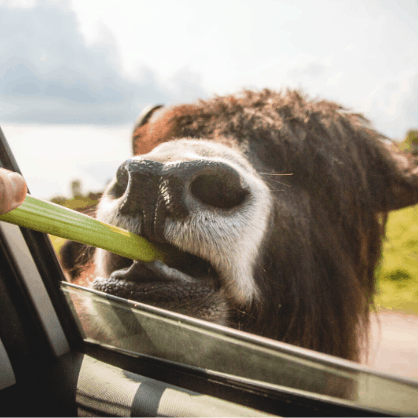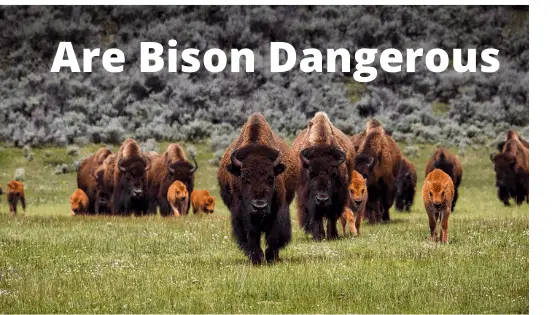Are Buffalo Dangerous to People
If you’ve ever wondered if bison are dangerous to humans, then this article is specifically for you. But before we get into that, what is a bison? And how dangerous is it to humans?
Yes, Now this is scary. According to a 2000 study, Yellowstone’s bison are actually more dangerous than its bears. The study found that bison had charged people 81 times over 22 years, killing two. The park’s grizzly bears meanwhile had injured 30 and killed two, the AP reported.
What Are Bison / Buffalo
Sometimes known as the American bison or buffalo, is a wild breed of the buffaloes that has its roots as a North American species of bison, which once roamed the vast herds of North America.
For More Educational Resources on Buffalo / Bison Check Out what Amazon Has to Offer
Along the line, bison threatened to go extinct, and that’s when Yellowstone National Park, a wild animal reservation in America, decided to take them into their wildlife reservation.
Wild Herds
Predators to Buffalo
At One Time Great Seas of Wild American Bison Romed the Plains of the Western States. History is full of stories of the Indian Tribes that followed the Great Herds of Thousands of Buffalo, that provided Food, Clothing, and shelter to the Indians.
Indians – Hunting These Great animals Adult males can get to 2200 Lbs, and females being smaller up to 1200 Lbs. If a Cow happens to be with or has given birth to a calf – she can be very protective. The Bison having very few Natural predators, possibly Wolves hunting Packs – to prey upon the Young or weak of the Herds.
Buffalo hunters – During the Great expansion to the west – Buffalo pelts became highly sought after – This resulted in the Great Slaughtering of the Once large population of Wild herds. They then sold the Hides back East to Fur Traders.
Wolves – Wolves usually would hunt in Packs. They Generally would try to separate out a young calf, or one of the weaker animals. They would Hunt as a pack and take down their Prey. Wolves did it for food, and it would have a positive effect on the herds – culling out the sick and weaker animals.
Mountain Lions – Have been known to Hunt and Feed on Buffalo
Grizzly Bears – have been known to kill and eat younger animals.
Domesticated Herds
Today there are Bison Farms that have begun farming and Domesticating Herds of farm-raised Buffalo. today Bison Meat is very healthy and a very Lean Meat that is sold in many Markets.
These Domesticated herds can provide both Meat and hides in a well managed and controlled environment. Today Small Herds are found in Many States, Ohio, Illinois, Wyoming, so many local farmers are expanding into this growing new market.
Domesticated Herds are much safer to be around. They have been exposed to a lot of Human Interaction. Reliance upon Feed that is given to them. Also many have been born in captivity, only knowing farm life from Conception.
many are raised in contained environments – Young Buffalo being slaughtered for their tender meat at age of Approximately 18 months of Age – some of the Markets selling this tender meat at approx 8.99 Lb at Walmart today.
FAQ’s
- What is the difference between Bison and Buffalos – These Terms refer to the same animal – the American Buffalo
- Yellowstone Herd Population – Ranges from 2,300 – 5,200 individual animals
- Buffalo is not an Endanger species
- Approx 400,00 Bison are raised in domesticate environments
- Buffalo are very fast have been clocked up to 35 MPH
- Females are called Cows – males are Called Bulls
- Buffalo are Ruminants – like cattle, they graze on grasses and also eat domesticated feed like cattle
- Bulls can weigh over 2,000 Lbs, and Cows are generally smaller over 1,000 Lbs
- Cows generally have one calf, they are pregnant for 9 – 11 months and the young calves will stay close to their mother up to three years – in the Wild
- Rut fro buffalo is generally from July – August each Year
- Bulls will Fight during the Mating time of Rut to wins a Cows affection
- Dominant Bull can mate with up to 50 Females
- When attacked Buffalo will fight together against an oncoming predator
- Buffalo in the wild are migratory – the Following food and avoiding severe weather
- Buffalo / Bison – Sleep Lying down – they bed down and squat down on the ground to sleep
- Both Bull and Cow Bisons – Male and female have Horns
- During Indian times – Their Hides were used as Buffalo Robes, Skins for their TePees, Making Saddles and Shoes – from tanned hides.
- Dried Buffalo meat is called pemmican
- Indians ate the Brain – Liver – Muscle – Grisle – they were eaten raw
- Asia and Africa are thought to be the Origin of the American Buffalo
- Can Cattle be Bred with Bison – Yes they are called Beefalo
- Buffalo are not Milked Commercially for Human Consumption
- Bison will eat approx 25 lbs of Grasses, feed per day
- When Escaping from a Buffalo – Climb a tree – Buffalo cannot Climb
Quick Facts About Bison Herd in Yellowstone
- Here are some facts. about the national park in America that houses one of the wildest reservations.
- Yellowstone is the only place in the United States where bison have lived continuously since prehistoric times,” according to the National Park Service.
- A number of Native American tribes especially refer to Yellowstone’s bison as pure descendants of the vast herds that once roamed the grasslands of the United States.
- The largest bison population in the country on public land resides in Yellowstone. It is one of the few herds free of cattle genes.”
- Tourists travel from all other the continent down to Yellowstone to witness their amazing wildlife reservations.
- The park has its own media, emergency/rescue team, and tour guides that give out instructions to tourists on how they should thread in the park. Instructions like how far one can go to a wild animal like bison.
But over the years, while there seem to be less controversial stories surrounding the visitation of other wild animals in the park by tourists, the same can barely be said about bison.
This is because several, it has been reported that bison have attacked tourist most frequently than any other wild animals in the park. Which then takes us to our next point, how dangerous are bison to a human?
THE DANGEROUS NATURE OF BISON
Statistics Show – According to a 2000 study done on the Buffalo Herd in Yellowstone, Yellowstone’s bison are actually more dangerous than its bears. The study found that bison had charged people 81 times over 22 years, killing two. The park’s grizzly bears meanwhile had injured 30 and killed two, the AP reported.
Examples of Bison attacks on Humans in 2015
- On the 21st of February, 2015, a male visitor from Massachusetts in his mid-50s was gored by a bull bison near the Norris Campground. Although he did not deliberately taunt the bison, instead, he simply allowed the bison to approach him closer than he should have, leaving the distance between them at just a few feet away from where he was sitting. As a result, the bison tossed the man into the air at nearly 10 feet off the ground level, thus resulting in the man having to break his collarbone, shoulder blade, several ribs, and a groin injury. The victim was immediately airlifted to a hospital in Idaho Falls, ID and fortunately survived after days of treatment.
- Another attack was on the 30th of March 2015, when a 43-year-old Mississippi woman and her six-year-old daughter were taking a selfie right in front of a wild bison. As she was taking the selfies, the huge animal immediately attacked her. Given that she was backing the bison before she could run from the animal who was barely six yards away, the bison caught up with her, and threw the woman into the air, according to a report from the Associated Press. The unidentified tourist woman was rushed to a nearby clinic and treated for minor injuries. At the time, the attack was recorded as the fifth bison attack on tourists, at the Yellowstone Park.
- On April 15, 2015, a 16-year-old Taiwanese exchange student similarly turned her back on a bison to pose for a group photo when the huge bison monster rushed towards her in a quick pace. Her case just like the rest was annoying because, the park rangers do tell tourists to remain at least 25 yards from bison, given that the wild animal can run up to 30 miles per hour. Still, the girl failed to heed to the instructions and stood between three to six feet away from the animal when it attacked, goring her in the buttocks. According to the National Park Service, when the park rangers arrived at the scene to rescue her, they found concerned tourists standing less than 10 feet away from the very same bison. Absurd if you ask me. Nevertheless, the Taiwanese teen was airlifted to a hospital with serious but at least not fatal injuries.
- On June 2, 2015, an Australian man was taking some photos five feet away from a 2,000-pound bison in the same area when the bull suddenly charged him, hooking him with its horns, and tossing him into the air more than once. According to CNN, the man miraculously survived the attack.
- On June 23, 2015, a teenage park concession stand worker, had just rounded up her late-night swim in the Firehole River when she stumbled upon a bison. She, too, was thrown into the air, suffering minor injuries.
- Some weeks later, a 68-year-old Georgia woman was hiking along Storm Point Trail when she was gored by a bison. She was hospitalized immediately, and again survived.
Solution
Now the truth is, most of the incidents between bison and humans are often as a result of our recklessness in heeding to instructions. According to park spokeswoman Amy Bartlett, “People are getting way too close,” she told the AP after Tuesday’s attack.
“The [woman] said they knew they were doing something wrong but thought it was okay because other people were nearby,” she also said.
So, the question is quite simple, and so is a solution. Are bison dangerous to humans? Yes, absolutely!
What can you do to avoid their attack? Stay off their tracks. Avoid taking a reckless and irrational risk, all in the name of adventure. You need to always remember that bison are not your friend, and whenever they see humans, their first port of reasoning is to attack.

So, be wise and stay safe! When you are visiting Yellowstone as a Tourist, Take heed to Fowwow all Safety Precautions. These Wild Herds in the Wild – are Wild Animals -They have a natural inner Fear of Man.
Sometimes this might be softened by frequent contact. Also by the Feeding that Takes Place. These Wild Herds have not been domesticated, so it is wise to use extreme Caution in getting close to these magnificent Ruminants of the Western Plains.


